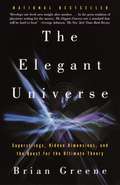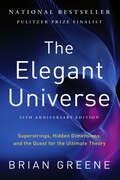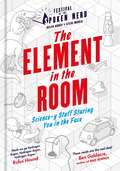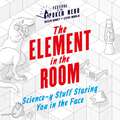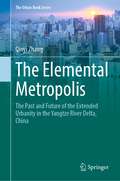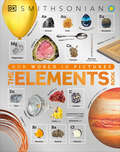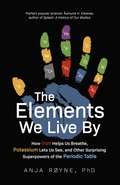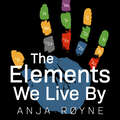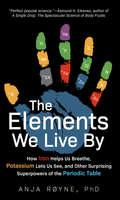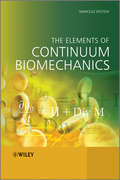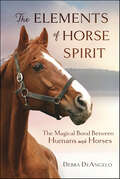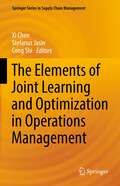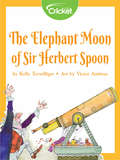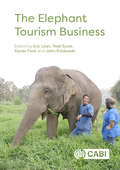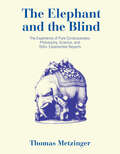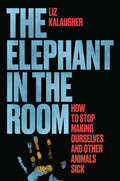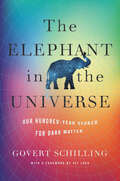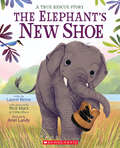- Table View
- List View
The Elegant Universe: Superstrings, Hidden Dimensions, and the Quest for the Ultimate Theory
by Brian R. GreeneGreene, one of the world's leading string theorists, peels away the layers of mystery to reveal a universe of 11 dimensions where the fabric of space tears and repairs itself, in this "New York Times" bestseller that features a new Preface and Epilogue.
The Elegant Universe: Superstrings, Hidden Dimensions, and the Quest for the Ultimate Theory (25th Anniversary Edition)
by Brian GreeneNATIONAL BESTSELLER Finalist for the Pulitzer Prize A new edition of the iconic bestseller that introduced legions to modern physics and the quest for the ultimate understanding of the cosmos, featuring a new preface and epilogue. With a rare blend of scientific insight and writing as graceful as the theories it so deftly explains, The Elegant Universe remains the unrivaled account of the modern search for the deepest laws of nature: “a standard that will be hard to beat” (George Johnson, New York Times Book Review). In this new 25th anniversary edition, renowned physicist and author Brian Greene—“the single best explainer of abstruse concepts in the world today” (Washington Post)—updates his classic work with a new preface and epilogue summarizing the significant theoretical and experimental developments over the past quarter-century. From established science, including relativity and quantum mechanics, to the cutting edge of thinking on black holes, string theory, and quantum gravity, The Elegant Universe makes some of the most sophisticated concepts ever contemplated thoroughly accessible and entertaining, bringing us closer than ever to comprehending how the universe works.
The Element in the Room: Science-y Stuff Staring You In The Face
by Helen Arney Steve Mould'They make science fun and understandable which is a great combo.' Sandi Toksvig 'These nerds are the real deal.' Ben Goldacre, author of BAD SCIENCE Why is it impossible to spin your right foot clockwise while you draw a 6 with your right hand? Can you extract DNA from a strawberry daiquiri? Would you make love like a praying mantis? Should you book a holiday on Earth 2.0? The Element in the Room will take you on a rib-tickling, experiment-fuelled adventure to explain everyday science that is staring you in the face. If you are sci-curious, pi-curious or just the-end-is-nigh-curious then this is the book for you.Steve Mould and Helen Arney are two thirds of science comedy phenomenon Festival of the Spoken Nerd. As a trio they have appeared on QI, created their own experimental* comedy show 'Domestic Science' for Radio 4, toured their stand-up science shows to over 50,000 nerds (and non-nerds) and accumulated millions of views on YouTube.'Made me go Hydrogen Argon, Hydrogen Argon, Hydrogen Argon.' Rufus Hound'MIND BLOWN.' Tim Harford'Science was never such hilarious explosive fun.' Richard Herring'This book is 37% better than mine. But it took 100% more nerds to write it.' Matt Parker (the other third of Spoken Nerd)
The Element in the Room: Science-y Stuff Staring You in the Face
by Helen Arney Steve Mould'Made me go Hydrogen Argon, Hydrogen Argon, Hydrogen Argon.' Rufus HoundAs featured in Best stocking-filler books of 2017 - The Guardian'Witty and clever writing, every topic is engaging, fun and in some cases laugh-out-loud funny...there are too many highlights to mention' - How it Works Why is it impossible to spin your right foot clockwise while you draw a 6 with your right hand? Can you extract DNA from a strawberry daiquiri? Would you make love like a praying mantis? Should you book a holiday on Earth 2.0? The Element in the Room will take you on a rib-tickling, experiment-fuelled adventure to explain everyday science that is staring you in the face. If you are sci-curious, pi-curious or just the-end-is-nigh-curious then this is the book for you.Steve Mould and Helen Arney are two thirds of science comedy phenomenon Festival of the Spoken Nerd. As a trio they have appeared on QI, created their own experimental* comedy show 'Domestic Science' for Radio 4, toured their stand-up science shows to over 50,000 nerds (and non-nerds) and accumulated millions of views on YouTube.'These nerds are the real deal' - Ben Goldacre, author of BAD SCIENCE 'They make science fun and understandable which is a great combo.' Sandi Toksvig'MIND BLOWN.' Tim Harford'Science was never such hilarious explosive fun.' Richard Herring'This book is 37% better than mine. But it took 100% more nerds to write it.' Matt Parker (the other third of Spoken Nerd)
The Element in the Room: Science-y Stuff Staring You in the Face
by Helen Arney Steve Mould'Made me go Hydrogen Argon, Hydrogen Argon, Hydrogen Argon.' Rufus Hound As featured in Best stocking-filler books of 2017 - The Guardian 'Witty and clever writing, every topic is engaging, fun and in some cases laugh-out-loud funny...there are too many highlights to mention' - How it Works Why is it impossible to spin your right foot clockwise while you draw a 6 with your right hand? Can you extract DNA from a strawberry daiquiri? Would you make love like a praying mantis? Should you book a holiday on Earth 2.0? The Element in the Room will take you on a rib-tickling, experiment-fuelled adventure to explain everyday science that is staring you in the face. If you are sci-curious, pi-curious or just the-end-is-nigh-curious then this is the book for you. Steve Mould and Helen Arney are two thirds of science comedy phenomenon Festival of the Spoken Nerd. As a trio they have appeared on QI, created their own experimental* comedy show 'Domestic Science' for Radio 4, toured their stand-up science shows to over 50,000 nerds (and non-nerds) and accumulated millions of views on YouTube. 'These nerds are the real deal' - Ben Goldacre, author of BAD SCIENCE 'They make science fun and understandable which is a great combo.' Sandi Toksvig 'MIND BLOWN.' Tim Harford 'Science was never such hilarious explosive fun.' Richard Herring 'This book is 37% better than mine. But it took 100% more nerds to write it.' Matt Parker (the other third of Spoken Nerd)
The Element in the Room: Science-y Stuff Staring You in the Face
by Helen Arney Steve Mould'They make science fun and understandable which is a great combo.' Sandi Toksvig 'These nerds are the real deal.' Ben Goldacre, author of BAD SCIENCE Why is it impossible to spin your right foot clockwise while you draw a 6 with your right hand? Can you extract DNA from a strawberry daiquiri? Would you make love like a praying mantis? Should you book a holiday on Earth 2.0? The Element in the Room will take you on a rib-tickling, experiment-fuelled adventure to explain everyday science that is staring you in the face. If you are sci-curious, pi-curious or just the-end-is-nigh-curious then this is the book for you.Steve Mould and Helen Arney are two thirds of science comedy phenomenon Festival of the Spoken Nerd. As a trio they have appeared on QI, created their own experimental* comedy show 'Domestic Science' for Radio 4, toured their stand-up science shows to over 50,000 nerds (and non-nerds) and accumulated millions of views on YouTube.'Made me go Hydrogen Argon, Hydrogen Argon, Hydrogen Argon.' Rufus Hound'MIND BLOWN.' Tim Harford'Science was never such hilarious explosive fun.' Richard Herring'This book is 37% better than mine. But it took 100% more nerds to write it.' Matt Parker (the other third of Spoken Nerd)(P) 2017 Octopus Publishing Group
The Elemental Metropolis: The Past and Future of the Extended Urbanity in the Yangtze River Delta, China (The Urban Book Series)
by Qinyi ZhangThis book provides a multi-scale reading of the spatial “elements” in which the extensive urbanity in Yangtze River Delta is constructed, and from there an imagination of a new paradigm of urbanization. The urbanization in Yangtze River Delta today is in need of a new interpretation and paradigm. The delta is a territory with city cores but it also has vast dispersed urbanization where the agricultural and non-agricultural activities and spaces are mixed and interlinked, a desakota (McGee, 1991). This book attempts to answer a basic question: what is the desakota in the Yangtze River Delta made of? The research Horizontal Metropolis led by Prof. Paola Viganò at EPFL, Switzerland focuses on the form of the contemporary city – the fragmentary spatial condition and dispersed urbanity all over the world. The study on Yangtze River delta is part of its research frame.
The Elements Book: A Visual Encyclopedia of the Periodic Table (DK Our World in Pictures)
by DKPacked with more than 1,000 incredible images and full of fascinating facts, this children&’s book takes you on a visual and vibrant journey of all the chemical elements that make up our world. This eye-catching encyclopedia for kids is the perfect guide to the 118 chemical elements of the periodic table, for budding young scientists to explore. It explores the naturally occurring elements, as well as the man-made ones, and explains their properties and uses. This engaging encyclopedia for children aged 9-12, shows the many natural forms of each element, as well as a wide range of both everyday and unexpected objects in which it is found, making each element relevant to the child&’s world!Celebrate your child's curiosity as they explore:- Striking and detailed diagrams, drawings and illustrations on every page- A highly visual approach to learning - Ideal combination of colorful diagrams with infographic text boxes- Showcases chemical elements in their pure and raw forms- In association with The Smithsonian InstitutionThis captivating kids encyclopedia takes a look at all 118 elements on the periodic table, from Hydrogen to Helium, Potassium to Polonium, calcium to carbon and so much more! The striking illustrations, photographs and diagrams featured throughout provide an optimum visual learning experience for both children and adults alike, accompanied by an array of fun facts all about your favorite elements, and lesser-known ones like Terbium, Thallium and Boron - with easy-to-read accessible text for readers aged 9-12, yet can be enjoyed by the entire family, making this enthralling children&’s encyclopedia a beautiful and educational gift that can be passed down generations.Learn all about the world one picture at a time!If you like The Elements Book then why not complete the collection? Part of the highly visual Our World In Pictures series, avid readers can dive into the world of dinosaurs with The Dinosaur Book, become a vehicle virtuoso with Cars, Trains, Ships and Planes and venture on a journey across the globe with Countries, Cultures, People & Places.
The Elements We Live By: How Iron Helps Us Breathe, Potassium Lets Us See, and Other Surprising Superpowers of the Periodic Table
by Anja RøyneWINNER OF THE 2018 BRAGE PRIZE'[T]his lovely book. An enjoyable sweep through topics ranging from respiration to space exploration -solid science presented in an engagingly human way' Andrew Crumey, author of The Great Chain of Unbeing'Perfect popular science . . . not just a well-written story about the elements, but a book about being human in the world today'Åsmund H. Eikenes, author of Splash: A History of Our BodiesWe all know that we depend on elements for survival - from oxygen in the air we breathe to carbon in the molecular structures of all living things. But we seldom appreciate how, say, phosphorus holds our DNA together or how potassium powers our optic nerves enabling us to see.Physicist and award-winning author Anja Røyne takes us on an astonishing journey through chemistry and physics, introducing the building blocks from which we humans - and everything else in the world - are made. Not only does Røyne explain why our bodies need iron, phosphorus, silicon, potassium and many more elements in just the right amounts in order to function, she also shows us where in the world these precious elements are found (some of them in limited and quickly depleting quantities).Røyne helps us understand how precariously balanced our lives - and ways of living - really are, and to appreciate little known and generally unsung heroes of the periodic table in an entirely new light.
The Elements We Live By: How Iron Helps Us Breathe, Potassium Lets Us See, and Other Surprising Superpowers of the Periodic Table
by Anja RøyneWINNER OF THE 2018 BRAGE PRIZE'[T]his lovely book. An enjoyable sweep through topics ranging from respiration to space exploration -solid science presented in an engagingly human way' Andrew Crumey, author of The Great Chain of Unbeing'Perfect popular science . . . not just a well-written story about the elements, but a book about being human in the world today'Åsmund H. Eikenes, author of Splash: A History of Our BodiesWe all know that we depend on elements for survival - from oxygen in the air we breathe to carbon in the molecular structures of all living things. But we seldom appreciate how, say, phosphorus holds our DNA together or how potassium powers our optic nerves enabling us to see.Physicist and award-winning author Anja Røyne takes us on an astonishing journey through chemistry and physics, introducing the building blocks from which we humans - and everything else in the world - are made. Not only does Røyne explain why our bodies need iron, phosphorus, silicon, potassium and many more elements in just the right amounts in order to function, she also shows us where in the world these precious elements are found (some of them in limited and quickly depleting quantities).Røyne helps us understand how precariously balanced our lives - and ways of living - really are, and to appreciate little known and generally unsung heroes of the periodic table in an entirely new light.
The Elements We Live By: How Iron Helps Us Breathe, Potassium Lets Us See, and Other Surprising Superpowers of the Periodic Table
by Anja RøyneThis “excellent” popular science book explores just what we—and the things around us—are made of (Aftenposten, Norway).Some elements get all the attention: glittering gold, radioactive uranium—materials we call “precious” because they are so rare. But what could be more precious than the building blocks of life—from the oxygen in our air to the carbon in all living things?In The Elements We Live By, physicist and award-winning author Anja Røyne reminds us that we’d be lost without the quiet heroes of the periodic table. Our bodies need phosphorous to hold our DNA together, potassium to power our optic nerves, and many more elements—in just the right amounts—to function. Other fundamental elements keep our technology (and society) running: Our phones contain arsenic, boron, and gallium to control signals and store information; indium and tin for the touch screen; and lithium for the battery.Everything is made of elements—every galaxy, star, and planet—from the iron in Earth’s core to the silicon in its sand. But that doesn’t mean the elements we rely on will never run out; for example, about half the lithium we need is extracted from rocks in Australia, and the other half is from saltwater in Argentina and Chile. As Røyne travels the world to find where these elements exist (some in ever-shrinking amounts), she shows how vitally urgent it is for us to protect them—the elements of our very existence.“Not just a discussion of basic chemistry, this is a volume that looks at the human impact on the planet and what we can learn from nature…Useful for science or sociology courses that address the various impacts of natural resource development or for popular science readers.” —School Library Journal
The Elements of Continuum Biomechanics
by Marcelo EpsteinAn appealing and engaging introduction to Continuum Mechanics in BiosciencesThis book presents the elements of Continuum Mechanics to people interested in applications to biological systems. It is divided into two parts, the first of which introduces the basic concepts within a strictly one-dimensional spatial context. This policy has been adopted so as to allow the newcomer to Continuum Mechanics to appreciate how the theory can be applied to important issues in Biomechanics from the very beginning. These include mechanical and thermodynamical balance, materials with fading memory and chemically reacting mixtures.In the second part of the book, the fully fledged three-dimensional theory is presented and applied to hyperelasticity of soft tissue, and to theories of remodeling, aging and growth. The book closes with a chapter devoted to Finite Element analysis. These and other topics are illustrated with case studies motivated by biomedical applications, such as vibration of air in the air canal, hyperthermia treatment of tumours, striated muscle memory, biphasic model of cartilage and adaptive elasticity of bone. The book offers a challenging and appealing introduction to Continuum Mechanics for students and researchers of biomechanics, and other engineering and scientific disciplines.Key features:Explains continuum mechanics using examples from biomechanics for a uniquely accessible introduction to the topicMoves from foundation topics, such as kinematics and balance laws, to more advanced areas such as theories of growth and the finite element method..Transition from a one-dimensional approach to the general theory gives the book broad coverage, providing a clear introduction for beginners new to the topic, as well as an excellent foundation for those considering moving to more advanced application
The Elements of Horse Spirit: The Magical Bond Between Humans and Horses
by Debra DeAngeloDevelop a Deep, Magical Bond with Humanity's Oldest Spirit AllyHarness the amazing spiritual power of horses with this brilliant book on bridging the physical world of horses with the metaphysical realm of Horse Spirit. You'll enhance your life by connecting to equine energy and forging a powerful bond with actual horses and spirit guides.Explore the myths and history of horses as well as the long-lived symbiotic relationship humans have with them. Discover practical horsemanship activities and advice, techniques for working with the four elements, and hands-on exercises to strengthen your energetic connection to horses. This groundbreaking book also helps you choose the best horse for you, both physically and spiritually, and live in harmony with him. Through heartwarming personal stories and well-researched insights, Debra DeAngelo reveals the incredible ways in which horses heal, ground, and teach you to be better in everything you do.
The Elements of Joint Learning and Optimization in Operations Management (Springer Series in Supply Chain Management #18)
by Xi Chen Stefanus Jasin Cong ShiThis book examines recent developments in Operations Management, and focuses on four major application areas: dynamic pricing, assortment optimization, supply chain and inventory management, and healthcare operations. Data-driven optimization in which real-time input of data is being used to simultaneously learn the (true) underlying model of a system and optimize its performance, is becoming increasingly important in the last few years, especially with the rise of Big Data.
The Elements: A Very Short Introduction
by Philip BallThis Very Short Introduction is an exciting and non-traditional approach to understanding the terminology, properties, and classification of the chemical elements. It traces the history and cultural impact of the elements on humankind, and examines why people have long sought to identify the substances around them. The book includes chapters on particular elements such as gold, iron, and oxygen, showing how they shaped culture and technology. Looking beyond the Periodic Table, the author examines our relationship with matter, from the uncomplicated vision of the Greek philosophers, who believed there were four elements--earth, air, fire, and water--to the work of modern-day scientists in creating elements such as hassium and meitnerium. Packed with anecdotes, The Elements is a highly engaging and entertaining exploration of the fundamental question: what is the world made from?
The Elephant Moon of Sir Herbert Spoon
by Kelly TerwilligerSir Herbert Spoon alerts Cecil Spout, his butler, that he has spotted an elephant on the moon through his telescope.
The Elephant Tourism Business
by Eric Laws Anja Pabel Rebecca Winkler Clive Phillips Eric Brymer Andrew McLean Professor Noel Scott Melville Saayman Daniel Turner Professor Xavier Font Mucha Mkono Ann Suwaree Ashton Liv Baker Sumanth Bindumadhav Sarah Blaine Naphawan Chantradoan Saranphat Chotmanakul Qingming Cui Susanna Curtin Charlotte Day Nilakshi Galahitiyawe Vivek Gurusamy Nicole Hausler Jeffrey Dale Hobbs Claire Jenkinson Professor John Koldowski Naut Kusters Shilpa Mahbubani Somyot Ongkhluap Piengpen Na Pattalung Kannapa Pongponrat Bongkosh Rittichainuwat John Edward Roberts Andrea Saayman Jan Schmidt-Burbach Alokparna Sengupta Vinathe Sharma-Brymer Ramona Strödecke Daminda Sumanapala Marjorie Van Strein Isabelle Wolf Honggang XuElephant tourism is a growing activity in many countries across Asia and Africa and is popular with tourists from all parts of the world. Elephant tourism has grown rapidly, providing the only viable way for elephants and their owners to survive since the banning of logging. Old logging camps have been developed into sanctuaries for some elephants, but many other camps were established as entertainment centres, resulting in serious welfare issues for the elephants and their mahouts. The profits from elephant tourism in Asia have encouraged African operators to follow a similar business model. This book draws attention to the need for a comprehensive and rigorous focus on local solutions to improve the welfare of captive elephants, their mahouts and local residents, and to enhance tourists' experiences of elephant tourism. It achieves this by: - Critically reviewing recent research into elephant tourism. - Providing contemporary analytical case studies of elephant tourism policy and practice. The Elephant Tourism Business will contribute to a better understanding of how elephant tourism is organised, regulated and promoted, both in elephant areas and tourist origin countries. It identifies priorities for future research into elephant tourism and provides a unique, authoritative resource for researchers, elephant managers and administrators, and tourism managers. The book will be of interest to academics and practitioners with backgrounds in conservation, the environment, tourism and veterinary sciences, and will appeal to tourists keen to experience elephants in person.
The Elephant and the Blind: The Experience of Pure Consciousness: Philosophy, Science, and 500+ Experiential Reports
by Thomas MetzingerAn engaging and insightful journey into human consciousness.What if our goal had not been to land on Mars, but in pure consciousness? The experience of pure consciousness—what does it look like? What is the essence of human consciousness? In The Elephant and the Blind, influential philosopher Thomas Metzinger, one of the world's leading researchers on consciousness, brings together more than 500 experiential reports to offer the world's first comprehensive account of states of pure consciousness. Drawing on a large psychometric study of meditators in 57 countries, Metzinger focuses on &“pure awareness&” in meditation—the simplest form of experience there is—to illuminate the most fundamental aspects of how consciousness, the brain, and illusions of self all interact.Starting with an exploration of existential ease and ending on Bewusstseinskultur, a culture of consciousness, Metzinger explores the increasingly non-egoic experiences of silence, wakefulness, and clarity, of bodiless body-experience, ego-dissolution, and nondual awareness. From there, he assembles a big picture—the elephant in the parable, from which the book&’s title comes—of what it would take to arrive at a minimal model explanation for conscious experience and create a genuine culture of consciousness. Freeing pure awareness from new-age gurus and old religions, The Elephant and the Blind combines personal reports of pure consciousness with incisive analysis to address the whole consciousness community, from neuroscientists to artists, and its accessibility echoes the author&’s career-long commitment to widening access to philosophy itself.
The Elephant in the Room: How to Stop Making Ourselves and Other Animals Sick
by Liz KalaugherA healthier future starts with seeing the human causes of wildlife diseases. When new diseases spread, news reports often focus on wildlife culprits—rodents, monkeys and mpox; bats and COVID-19; waterfowl and avian flu; or mosquitoes and Zika. But, in this urgent and engaging book, we see it often works the other way around—humans have caused diseases in other animals countless times, through travel and transport, the changes we impose on our environment, and global warming. With science journalist Liz Kalaugher as our guide, we meet the wildlife we have harmed and the experts now studying the crosscurrents between humans, other animals, and health. Herds of buffalo in Kenya, cloned ferrets in Colorado, and frogs shipped worldwide as living pregnancy tests for humans, all help Kalaugher dive into the murky backstories behind wildlife epidemics past and present. We learn that military conflict likely contributed to the spread of rinderpest, or cattle plague, throughout Africa, devastating pastoral communities. That crowded poultry farms may create virulent new forms of bird flu that spill back into the wild. And that West Nile virus—which affects not only birds and humans, but other animals, including horses, skunks, and squirrels—is spreading as global temperatures rise. Expanding today’s discussions of environmental protection to include illness and its impact, Kalaugher both sounds the alarm and explores ways to stop the emergence and spread of wildlife diseases. These solutions start with a simple lesson: when we protect other animals, we protect ourselves.
The Elephant in the Universe: Our Hundred-Year Search for Dark Matter
by Govert SchillingAn award-winning science journalist details the quest to isolate and understand dark matter—and shows how that search has helped us to understand the universe we inhabit. When you train a telescope on outer space, you can see luminous galaxies, nebulae, stars, and planets. But if you add all that together, it constitutes only 15 percent of the matter in the universe. Despite decades of research, the nature of the remaining 85 percent is unknown. We call it dark matter. In The Elephant in the Universe, Govert Schilling explores the fascinating history of the search for dark matter. Evidence for its existence comes from a wealth of astronomical observations. Theories and computer simulations of the evolution of the universe are also suggestive: they can be reconciled with astronomical measurements only if dark matter is a dominant component of nature. Physicists have devised huge, sensitive instruments to search for dark matter, which may be unlike anything else in the cosmos—some unknown elementary particle. Yet so far dark matter has escaped every experiment. Indeed, dark matter is so elusive that some scientists are beginning to suspect there might be something wrong with our theories about gravity or with the current paradigms of cosmology. Schilling interviews both believers and heretics and paints a colorful picture of the history and current status of dark matter research, with astronomers and physicists alike trying to make sense of theory and observation. Taking a holistic view of dark matter as a problem, an opportunity, and an example of science in action, The Elephant in the Universe is a vivid tale of scientists puzzling their way toward the true nature of the universe.
The Elephant's New Shoe
by Laurel NemeThis sweet true story stars a tiny, orphaned elephant who was given another chance.When Chhouk, an Asian elephant calf, was found, he was alone, underweight, and had a severe foot injury. Conservationist Nick Marx of Wildlife Alliance rescued the baby elephant. With help from the Cambodian Forestry Administration, the Cambodian School of Prosthetics and Orthotics, and an elephant named Lucky, Nick nursed Chhouk back to health and made him an artificial foot. One of the first animals to ever be fitted with a prosthetic, Chhouk helped pioneer the technology -- and most importantly, was able to walk again!This true animal rescue story will satisfy animal lovers and capture the hearts of both young readers and their parents.
The Elephant's Secret Sense
by Caitlin O'ConnellWhile observing a family group of elephants in the wild, Caitlin O'Connell, a young field scientist, noticed a peculiar listening behavior. A matriarch she had been watching for months turned her massive head and lifted her foot off the ground. As she scanned the horizon, the other elephants followed suit, all facing the same direction. O'Connell soon made a groundbreaking discovery: the elephants were "listening through limbs," feeling the ripples of the earth's surface for approaching friends and enemies. Through their feet, toenails, trunks, and other, subtler modes of communication, these enormous animals were communicating to one another, demonstrating the vital importance of social relationships in their lives. Yet this grand revelation about the intelligence of wild animals is also a story of the relationship between humans and elephants as neighbors, vying for the same resources of an increasingly crowded continent. For when O'Connell was first contracted by the Namibian government to develop new methods to deter elephants from raiding villagers' crops, she was unprepared for what she would encounter -- political upheaval, tribal disputes, inhumane poachers, and a fundamentally ineffective approach to wildlife conservation. Despite these setbacks, she came to know and love each of the fascinating, unique elephants under her watchful eye, while at the same time witnessing a change in attitude and policy, providing hope for the elephant's future. An unforgettable journey of scientific discovery, The Elephant's Secret Sense takes you deep into the wilds of Namibia, from the tops of isolated, desert observation towers to the jaws and claws of ravenous lions to aerial expeditions and dusty highways, where the naturalists do their difficult work in a troubled land threatened by expanding human populations and unstable politics. Resonant with the powerful calls of the mysterious elephant, this is a story about the resilience of nature and the inspiring, astonishing, and often heartbreaking places where humans and wild animals come together.
The Elevator Escalator Book: A Transportation Fact Book
by Bob BarnerFrom the Book Jacket: Did you ever wonder what makes an elevator go up and down? Did you ever want to know what happens to the stairs at the top of an "up" escalator? Would you like to know how fast and how high a jet can fly? If you would like to know how these types of transportation and others get us around, just follow the big, brown, furry dog with his brightly wrapped present on his trip. Along the way he'll take twelve different kinds of transportation and you'll get to see how each one works. Plus, you'll find out what the big, brown, furry dog is going to do with his present! Bob Barner is a freelance artist whose clients include the hew England Aquarium and several zoos and circuses. He has written and illustrated two other books for children. The Elephants Visit and Elephant Facts. Mis home is in Boston, Massachusetts.
The Elizabethan World Picture
by E. M. W. TillyardMy object then is to extract and expound the most ordinary beliefs about the constitution of the world as pictured in the Elizabethan age and through this exposition to help the ordinary reader to understand and to enjoy the great writers of the age. In attempting this I have incidentally brought together a number of pieces of elementary lore which I have not found assembled elsewhere. This book may actually be a convenient factual aid to the bare construing of some of Spenser or Donne or Milton.
The Ellesmere Wolves: Behavior and Ecology in the High Arctic
by L. David Mech Morgan Anderson H. Dean CluffIn a fascinating story of discovery and science, we meet a remote population of wolves unafraid of humans. For parts of twenty-four summers, wolf biologist L. David Mech lived with a group of wolves on Ellesmere Island, some six hundred miles from the North Pole. Elsewhere, most wolves flee from even the scent of humans, but these animals, evolving relatively free from human persecution, are unafraid. Having already spent twenty-eight years studying other populations of wolves more remotely by aircraft, snow-tracking, live-trapping, and radio-tracking, Mech was primed to join their activities up close and record their interactions with each other. This book tells the remarkable story of what Mech—and the researchers who followed him—have learned while living among the wolves. The Ellesmere wolves were so unconcerned with Mech’s presence that they allowed him to camp near their den and to sit on his all-terrain vehicle as he observed them, watching packs as large as seven adults and six pups go about their normal activities. In these extraordinarily close quarters, a pup untying his bootlace or an adult sniffing his gloved hand was just part of daily life. Mech accompanied the wolves on their travels and watched as they hunted muskoxen and arctic hares. By achieving the same kind of intimacy with his wild hosts’ every action that we might experience living with domesticated dogs, Mech gained new insights into common but rarely studied behaviors like pup feeding, food caching, howling, and scent-marking. After Mech’s time at Ellesmere ended, his coauthors and fellow wolf researchers Morgan Anderson and H. Dean Cluff spent parts of four summers studying the wolves via radio collars, further illuminating the creatures’ movements and ecology. This book synthesizes their findings, offering both a compelling scientific overview of the animals’ behavior—from hunting to living in packs to rearing pups—and a tale of adventure and survival in the Arctic.
